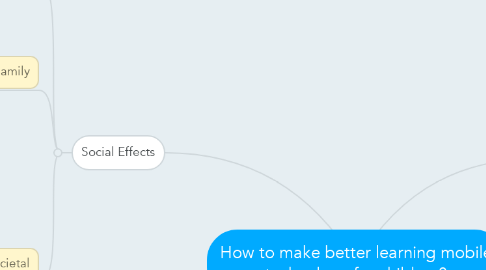
1. Disruption
1.1. Issue of distraction in schools
1.2. Avoiding information overload
2. Social Effects
2.1. Individual
2.1.1. Improved quality of childhood
2.1.2. Health Risks
2.1.3. Infrastructure required for tech (Time, training, money, adoption)
2.1.4. Security - who to blame when child gets "hurt" by tech
2.1.5. Challenge to find local application of education and technology
2.2. Family
2.2.1. Opportunity to build family ties
2.2.2. Parent's role is emphasized
2.3. Societal
2.3.1. Perception
2.3.1.1. Challenging unfavourable public perceptions which leads to lack of R&D
2.3.1.2. Reframing Cultural Norms and Attitudes
2.3.2. Inequality
2.3.2.1. Technology as a measure of inequality
2.3.2.2. Larger gap unless someone pays
2.3.2.3. Challenging Unequal Access to Technology
2.3.2.4. Addressing Differentiated Access and Technology
2.3.3. Adaptation
2.3.3.1. Challenge in handling invasive technology
2.3.3.2. Reinforcing online privacy legislation for children
2.3.3.3. Opportunity in evolution and innovation of native/pre-existing technology
3. 21st Century
3.1. Defining literacy
3.2. Advancing 21st century skills in children
4. Infrastructure
4.1. Software
4.1.1. Mobile marketplaces for children
4.1.2. Content filtering for Internet-enabled learning
4.1.3. Massive Open Online Courses (MOOCs)
4.2. Hardware
4.2.1. Capacity of existing technological infrastructure
4.2.2. Challenge: Battery Life
4.2.3. Choosing hardware for learning
4.3. Design
4.3.1. Human-Computer Interaction Design
4.3.1.1. Challenge: Facing disruption and designing for small screens
4.3.2. Architectural Design for Infrastructure
4.3.2.1. Challenge: Implement, integrate, manage and maintain technologies
4.3.2.2. Mobile device management at schools
5. Learning
5.1. The Right Mix
5.1.1. Tension between new technology and education
5.1.2. Cost effectiveness
5.2. Collaboration
5.2.1. Learning networks
5.2.2. Problem Solving
5.3. Personalized
5.3.1. Supporting learning and learners
5.3.2. 360 degree approach
5.3.3. Increasing motivation in children
5.3.4. Reevaluating assessment criteria

